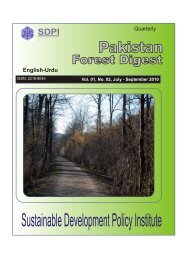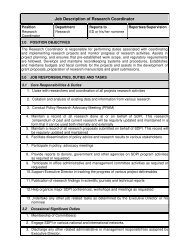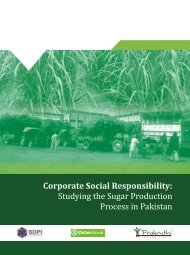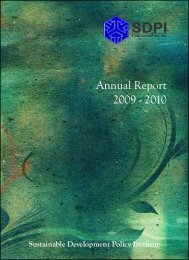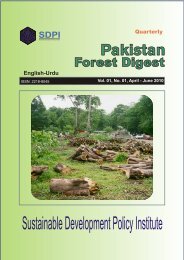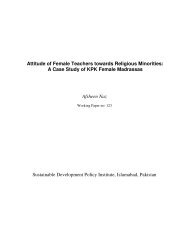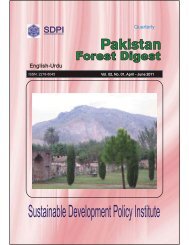The Kyoto Protocol and Sustainable Development
The Kyoto Protocol and Sustainable Development
The Kyoto Protocol and Sustainable Development
Create successful ePaper yourself
Turn your PDF publications into a flip-book with our unique Google optimized e-Paper software.
<strong>The</strong> <strong>Kyoto</strong> <strong>Protocol</strong> <strong>and</strong> <strong>Sustainable</strong><strong>Development</strong>Shaheen Rafi KhanWorking Paper Series # 812002
All rights reserved. No part of this paper may be reproduced or transmitted in any form or by any means,electronic or mechanical, including photocopying, recording or information storage <strong>and</strong> retrieval system,without prior written permission of the publisherA publication of the <strong>Sustainable</strong> <strong>Development</strong> Policy Institute (SDPI).<strong>The</strong> opinions expressed in the papers are solely those of the authors, <strong>and</strong> publishing them does not in anyway constitute an endorsement of the opinion by the SDPI<strong>Sustainable</strong> <strong>Development</strong> Policy Institute is an independent, non-profit think-tank founded for doingresearch on sustainable development.WP- 081- 002- 060- 2002- 020© 2002 by the <strong>Sustainable</strong> <strong>Development</strong> Policy InstituteMailing Address: PO Box 2342, Islamabad, Pakistan.Telephone ++ (92-51) 2278134, 2278136, 2277146, 2270674-76Fax ++(92-51) 2278135, URL: www.sdpi.org
Table of ContentsAbstract................................................................................................................................... 1<strong>The</strong> politics of the <strong>Kyoto</strong> <strong>Protocol</strong> (KP) ................................................................................... 1Is the KP fair? A view from the south...................................................................................... 4Do developing countries need to mitigate?............................................................................. 6Conclusion ............................................................................................................................ 12Bibliography .......................................................................................................................... 13
<strong>The</strong> <strong>Sustainable</strong> <strong>Development</strong> Policy Institute is an independent, non-profit, non-government policyresearch institute, meant to provide expert advice to the government (at all levels), public interest <strong>and</strong>political organizations, <strong>and</strong> the mass media. It is administered by an independent Board of Governors.Board of Governors:Dr Amir MuhammadChairman of the BoardMr. Javed JabbarPresident, MNJ Communications Pvt. LtdMr. Irtiza HusainDirector, Pakistan Petroleum LtdMs Khawar MumtazCoordinator, Shirkat GahMr. Shamsul MulkMinister For Irrigation, NWFPDr Abdul Aleem ChaudhryDirector, Punjab Wildlife Research CentreMr. Mohammad RafiqHead of Programme IUCN, PakistanDr Zeba A. SatharDeputy Country Representative, Population CouncilMr. Malik Muhammad Saeed KhanMember, Planning CommissionDr. Pervez HoodbhoyProfessor, Quaid-e-Azam UniversityKaramat AliDirector, PILERDr Saba Gul KhattakExecutive Director, SDPIUnder the Working Paper Series, the SDPI publishes research papers written either by the regular staff ofthe Institute or affiliated researchers. <strong>The</strong>se papers present preliminary research findings either directlyrelated to sustainable development or connected with governance, policy–making <strong>and</strong> other social scienceissues which affect sustainable <strong>and</strong> just development. <strong>The</strong>se tentative findings are meant to stimulatediscussion <strong>and</strong> critical comment.
<strong>The</strong> <strong>Kyoto</strong> <strong>Protocol</strong> <strong>and</strong> <strong>Sustainable</strong> <strong>Development</strong>Shaheen Rafi KhanAbstractOn the basis of their present <strong>and</strong> projected per capita emissions, developing countries are not likely to bekey players in global warming with such emissions being well below the global average. This paperargues that developing countries have no intrinsic reason to buy into the ‘mitigation groundswell’ drivenby Northern global warming concerns, of which the clean development mechanism (CDM) is the mostrecent manifestation. On the other h<strong>and</strong>, the local consequences of GHG emissions present morecompelling evidence for Pakistan to make an effort to abate such emissions. Also, market incentives <strong>and</strong>the complex north-south dynamics associated with CDMs will either induce or compel the South to buyinto the CDM process. At that stage, it should come armed with its own menu of options – one driven bysustainable development concerns.1. <strong>The</strong> politics of the <strong>Kyoto</strong> <strong>Protocol</strong> (KP)<strong>The</strong> United Nations Framework Convention on Climate Change (UNFCCC) adopted in 1992 <strong>and</strong> ratifiedin 1994, was an important first step towards framing a global response to climate change. <strong>The</strong> UNFCCCgoal is to "protect the climate system for present <strong>and</strong> future generations by seeking to stabilize greenhousegas concentrations in the atmosphere at a level preventing dangerous anthropogenic interference with theclimate system." <strong>The</strong> UNFCCC charter articulates specific principles as a basis for future action onclimate issues. <strong>The</strong>se include equity, sustainable development, reducing vulnerability of developingcountries <strong>and</strong> the need to take precautionary measures preceding scientific certainty. 1 In particular, Article4 of the Convention forcefully espouses developed country action in mitigating climate change.<strong>The</strong> third meeting of the Conference of Parties (COP-3) in <strong>Kyoto</strong> in 1997 formulated practical stepsaimed at making the UNFCCC principles operationally meaningful. <strong>The</strong> meeting concluded with 160countries signing the <strong>Kyoto</strong> <strong>Protocol</strong> (KP). <strong>The</strong> KP covenants included m<strong>and</strong>atory emission cuts <strong>and</strong>various mechanisms, guidelines <strong>and</strong> criteria for implementing them:• Annex 1 countries (industrialized countries <strong>and</strong> countries in transition) were required to reducetheir greenhouse gas emissions (GHG) by an average 5.2% below the base year, 1990, over theperiod 2008-2012. <strong>The</strong> variance around this average was quite large, with some countries actuallyenjoying emission entitlements. 2• No quantitative emission cuts would be imposed on developing countries in the first phase. Butthey could comply voluntarily <strong>and</strong> reap the financial benefits from emissions trading.• To become binding, the <strong>Protocol</strong> would need to be signed by 55% of Annex 1 countries,responsible for 55% of total GHG emissions.• <strong>The</strong> protocol sanctioned “emissions trading,” a generic term for different trading modes (quota<strong>and</strong> project based). It refers to market-driven transactions where high-emitting countries (whichface high costs of curbing emissions) can trade their obligations with low-emitting countries.International Emissions Trading (IET, Article 16, bis) is between KP Annex B (developed1 For details, see Aslam (Aslam, M.A.: 2000: pp 3-4)2 See Table 1, page 6 in Najam et al: 1998
<strong>The</strong> <strong>Kyoto</strong> <strong>Protocol</strong> <strong>and</strong> <strong>Sustainable</strong> <strong>Development</strong>country) parties only. Joint Implementation (JI, Article 6) also falls in this category. <strong>The</strong> Clean<strong>Development</strong> Mechanism (CDM, Article 12) is a separate category, which allows emissionstrading between developed <strong>and</strong> developing countries, which have no binding emission reductionrequirements. <strong>The</strong>re are also more nuanced distinctions: JI <strong>and</strong> CDM are distinct mechanisms.<strong>The</strong> general category under which all three fit is the “flexibility mechanisms,” though this term isnot found anywhere in the treaty.• Initially emissions reduction efforts would focus on projects in the Energy/Transport, Industry<strong>and</strong> Waste sectors deferring L<strong>and</strong> Use, L<strong>and</strong> Use Change <strong>and</strong> Forestry (LULUCF) projects to alater date. <strong>The</strong> reason was that while “sources” were easy to quantify, “sinks” were not. Forinstance, establishing credible baselines for forestry projects in developing countries could posemethodological problems. However, the “sinks” option was not ruled out.• An adaptation fund was to be set up to help developing countries cope with the impacts of secular<strong>and</strong> extreme climatic change. Among many options, one was to tax CDM projects so that aproportion of the funds could be used for adaptation activities in developing countries.1.1 Reactions to the KPA key concern underpinning the deliberations of the KP is that the m<strong>and</strong>atory emission cuts fall far shortof those required to slow down the atmospheric accumulation of GHGs. Experts argue that the proposed5.2 percent reduction is both too little <strong>and</strong> too late <strong>and</strong> that emission cuts of greater than 50 percent below1990 levels are required to arrest global warming effectively in the near future (Hadley Center, 1999).Revised predictions by the IPCC suggest that global warming could increase by as much as 5.8º C overthe next 100 years, a far grimmer scenario than envisioned originally. According to Friends of the EarthInternational (FOEI), the levels of carbon dioxide in the atmosphere, projected to be up 8 percent over1990 levels by 2010, will be only 0.4 percent lower if all the <strong>Kyoto</strong> targets are met – not nearly lowenough to halt climate change <strong>and</strong> all its predicted adverse impacts on developing countries. <strong>The</strong>refore,the importance of domestic cuts in the North cannot be stressed enough.Despite its shortcomings, the KP did not enjoy easy passage at subsequent COP meetings (COP 4 throughCOP 7). <strong>The</strong> US almost scuttled the proceedings <strong>and</strong>, ultimately, a watered down version of the originalprotocol was approved at COP 7 in Marrakesh. <strong>The</strong> US refused to endorse it. While the north <strong>and</strong> thesouth differed on most issues, intra-north accord was absent as well with the US, Japan <strong>and</strong> Australiataking inflexible positions, while the European Union (EU) was more conciliatory. Similarly, intra-south,some countries such as Brazil, Chile, Argentina, Indonesia <strong>and</strong> Malaysia bought into CDM mechanisms<strong>and</strong> voluntary compliance.With their heavy reliance on carbon-based fuels, most industrialized countries found the prospect ofmajor CO 2 emissions cuts unacceptable. <strong>The</strong> US proposed to deflect the burden of emission reductions toits existing, new <strong>and</strong> exp<strong>and</strong>ed forests. This alone would provide them with carbon credits equivalent toabout 60 percent of their reduction commitments. Along with Japan <strong>and</strong> Australia, it also lobbied stronglyto include LULUCF projects in JI <strong>and</strong> the CDM. <strong>The</strong> EU <strong>and</strong> most developing countries opposed theirinclusion. <strong>The</strong>ir objections stemmed from environmental <strong>and</strong> equity concerns <strong>and</strong> from the perceivedtechnical difficulties in calculating carbon absorption by soils <strong>and</strong> plants.By <strong>and</strong> large developing countries were equally unhappy with the provisions of the KP. With regard toemissions trading, they preferred to see the North meet the bulk of its commitment through cuts indomestic emissions (up to 80%). Otherwise, the root cause of the problem would be ignored, namely,2
SDPI Working Paper Series # 81unchecked fossil fuel burning. <strong>The</strong> US, Canada <strong>and</strong> others favored “unfettered trading”, while the EUproposed a complicated 50-50 system.A concern was that the CDM could become a vehicle for dumping less than cutting-edge technologies inthe South (because they are cheaper) <strong>and</strong> likely to become redundant some years down the line, leavingthe South with the onus of upgrading them. A shift to renewables would allay this concern, <strong>and</strong> meet thedual objectives of climate protection <strong>and</strong> sustainable development.<strong>The</strong> proposed Adaptation Fund came under scrutiny. While developing countries listed it as one of themain factors for signing the <strong>Protocol</strong> in 1997, in hindsight they reasoned it would raise the price of CDMprojects. <strong>and</strong> make them less competitive than emissions trading <strong>and</strong> Joint Implementation in the globalcarbon credits market. In order to establish a level playing field – <strong>and</strong> not lose an option they would becompelled to buy into anyway -- developing countries proposed that the adaptation fund be levied on allthree mechanisms.Other, relatively less contentious, issues revolved around legally binding consequences for noncompliance.<strong>The</strong> suggested options included “borrowing” from future commitment periods, a ComplianceFund that non-complying countries would pay into <strong>and</strong>, a Compliance Action Plan.1.2 What did the KP accomplish?<strong>The</strong> KP has been signed finally. And, following the World Summit on <strong>Sustainable</strong> <strong>Development</strong> (WSSD)in September this year -- notwithst<strong>and</strong>ing the Bush administration's refusal to ratify the <strong>Kyoto</strong> <strong>Protocol</strong> onclimate change, it accepted language that says nations backing <strong>Kyoto</strong> "strongly urge" states that have notdone so to ratify it in "a timely manner." Further in a move that could “assure the success of <strong>Kyoto</strong>,”Russia indicated that it expected Moscow to ratify the <strong>Protocol</strong> soon.In essence, the achievement is illusory. Because the US is a major emitter, contributing 35% of globalequivalent CO 2 emissions, its abstention at COP 8 meant that other countries were able to leverage moreconcessions both in terms of their quantitative commitments <strong>and</strong> the manner in which such commitmentswould be met. <strong>The</strong> revised protocol is a watered down version of its original self, so much so that manyinternational NGOs, like Greenpeace, fear that the new commitments represent an average increase inemission entitlements by 0.2%.Specifically, the diluted version of the original KP accepts: a) a reduction in original commitments from5.2 percent to 2.4 percent; b) the reduction does not have to occur at source but through ‘sinks’accreditation as well -- industrialized countries can attribute on-going afforestation <strong>and</strong> reforestationactivities towards their reduction targets; 3 c) there are no caps, meaning no restrictions on how much oftheir emissions industrialized countries must reduce domestically, <strong>and</strong> how much through emissionstrading; d) the caps for sinks projects within the CDM are generous (these are the cheapest type ofprojects <strong>and</strong>; e) no restrictions have been laid on coal <strong>and</strong> gas projects, <strong>and</strong> no priority given to renewableenergy projects.3 <strong>The</strong> only way any progress could be achieved was by granting major concessions to countries -- such as Japan<strong>and</strong> Australia -- that were critical to the process <strong>and</strong> who now enjoyed even more leverage, courtesy of the USabstaining. Russia also wrung huge concessions from the process based on the same dynamic.3
<strong>The</strong> <strong>Kyoto</strong> <strong>Protocol</strong> <strong>and</strong> <strong>Sustainable</strong> <strong>Development</strong>2. Is the KP fair? A view from the southA benchmark for assessing equity is the somewhat idealized southern stance taken by the Centre forScience <strong>and</strong> Environment (CSE), India. However, it is not an isolated view, <strong>and</strong> has found relatedresonances among civil society representatives in the North, such as the Stockholm Environment Institute(SEI). <strong>The</strong> CSE concludes that the covenants of the <strong>Kyoto</strong> <strong>Protocol</strong> (KP) are inequitable <strong>and</strong> built in themare perverse incentives to pollute. Its proposal, which combines fair entitlements with the principle ofconvergence, aims to produce equitable as well as effective outcomes.<strong>The</strong> drift of the argument is as follows. <strong>The</strong> KP has allocated entitlements to Annex 1 (developedcountries) <strong>and</strong> transition economies to pollute the environment. <strong>The</strong>se entitlements are implicit in theirnational commitments to lower emissions, (which amounts to a global 2.4% below the base year, 1990,by the year 2008-2012). In other words, their combined emissions – minus 2.4% -- would become frozenin perpetuity. In this manner, not only will northern countries legitimize their dismal historical record inpolluting the planet but will claim credit for doing their bit for global warming as well. As matters st<strong>and</strong>now, the emissions of one American are equal to those of 25 Indians, 33 Pakistanis, 42 Maldivians, 85 SriLankans, 125 Bangladeshis, 250 Bhutanese <strong>and</strong> 500 Nepalese. Not surprisingly, developing countries feelthey still have considerable emissions leeway in order to achieve their development objectives. Also, therelative emissions profile lends a flavor of filibuster to the US insistence that ratification should bepredicated upon quantifiable emission targets for developing countries.Najam et al (Najam <strong>and</strong> Page: SDPI: 1998) also question the choice of the base year, which, they argue,creates opportunities for “hot air accounting.” <strong>The</strong> argue that huge emission margins have built up since1990 in Eastern Bloc economies due to the recession <strong>and</strong> in countries such as Australia as a result ofbetter forestry practices. 4 In contrast, countries like the US have increased their emissions substantiallyover the same period. Diverging emission trends since 1990 would allow high emitting countries, such asthe US, to trade their commitments with countries, such as Eastern Europe <strong>and</strong> Australia, thanks to theiremerging emission margins. 5 Thus, targeted reductions may actually prove to be ephemeral withsubstantive emission cuts becoming hostage to creative hot air accounting. Also, the pathways toemission cuts are critical. Most industrialized countries would prefer to end-load their emissionreductions, which will mean greater additions to carbon concentrations as compared to what they wouldbe if emissions were reduced gradually.2.1 <strong>The</strong> Clean <strong>Development</strong> Mechanism (CDM): Is it equitable?Three mechanisms provide alternatives for committed emissions cuts for Northern countries: emissionstrading, Joint Implementation, International Emissions Trading <strong>and</strong> the Clean <strong>Development</strong> Mechanism.All three are based on the concept of paying for the privilege to keep on emitting domestically. This canbe done either by buying emissions space from a low-emitting country, as in the case of emissionstrading, or by investing in projects that will reduce emissions in another country, taking credit for theemissions reduced. Such mechanisms allow creditor countries to keep on burning fossil fuels in theircountries with as much – if not more – latitude than before, while getting credit at the same time formeeting their reduction targets.<strong>The</strong> most complete version is the CDM, in as much as it claims to be market-driven <strong>and</strong> promotessustainable development. CSE takes issue with both claims. It maintains that CDMs are just a means to4 In fact, aggregate emissions have actually fallen due to these developments.5 Also, such margins are not likely to reduce in a hurry due to emission control technologies on the shelf.4
SDPI Working Paper Series # 81ensure that the industrialized countries meet their emission reduction targets -- without actually loweringtheir own emissions -- at the lowest possible cost. Ostensibly market driven, the proposed arrangementsactually are designed to prod developing countries into cutthroat competition for funds. Worse still,developing countries will have bartered away their low-cost options, leaving future generations with theburden of implementing the most expensive cost options by the time they become subject to m<strong>and</strong>atoryemission reductions -- as they surely must, thanks to lack of effective compliance by the North. Thus,rather than the benign instruments they purport to be, CDMs are actually pernicious trading arrangements.<strong>The</strong> apparent lack of coercion makes them attractive for developing countries. Indeed there is evidencethey are buying avidly into it. Countries like Malaysia, Indonesia, <strong>and</strong> Pakistan already have or are in theprocess of setting up CDM offices to attract mitigation projects <strong>and</strong> investments. <strong>The</strong> race has begun withlow cost options being identified <strong>and</strong> submitted for funding. Projects priced as low as $14 per ton ofcarbon reduced are being offered, compared to the average $125 per ton it costs to reduce in the US.Seen this way, the proposed mechanisms are not equitable. A fair conjecture could be that manydeveloping countries are buying into CDMs because of their immediate need for foreign exchange.An opposing view is presented by Cosbey <strong>and</strong> Kellet (2002),One argument put forward by critics of the CDM is that it will allow Northerncountries to harvest the low-hanging fruit form the South – the cheap <strong>and</strong> easyemission reduction options – <strong>and</strong> gain credits for doing so. If <strong>and</strong> when thedeveloping countries eventually accept binding commitments to act, the argumentgoes, they will be left with only the most expensive options (Agarwal, 2000)From an environmental perspective this is a poor argument, akin to recommendingthat an athlete deliberately perform poorly so that he or she can more easily showshow great improvement later. <strong>The</strong> problem is that if we wait for the time whendeveloping countries make binding commitments <strong>and</strong> begin to harvest those cheapopportunities, the interim involves continued environmental degradation <strong>and</strong> itsassociated impacts on human health <strong>and</strong> well being.<strong>The</strong> argument is not straightforward from an economic perspective either. For onething, it assumes a static basket of technologies <strong>and</strong> management practices availablefor improving environmental performance. If we assume a dynamic basket – a farmore realistic assumption, particularly given the inevitable investment in innovationin the OECD countries – it is not obvious that the technological improvementsavailable in the future will be more costly than those now viable under the CDM.As well, most of the investment that would occur under the CDM is efficiencyenhancing or wealth creating. Deliberatley depriving <strong>and</strong> economy of suchinvestment is not cost-free. <strong>The</strong> high costs of inefficiency are inevitably visited ondomestic consumers, <strong>and</strong> on firms that lose market share in international competition.Those that advocate living with inefficient technologies to save the costs of transitionlater should consider the costs of waiting as well.However, Cosby <strong>and</strong> Kellett agree with the argument presented by the Stockholm EnvironmentInstitute (SEI) on flexibility mechanisms (including the CDM), which they feel undercuts the abilityof developed countries to make real change towards achieving the FCCC objectives.5
<strong>The</strong> <strong>Kyoto</strong> <strong>Protocol</strong> <strong>and</strong> <strong>Sustainable</strong> <strong>Development</strong><strong>The</strong> <strong>Kyoto</strong> <strong>Protocol</strong>’s “flexibility mechanisms”, as currently conceived, couldundermine the value of the <strong>Kyoto</strong> targets. <strong>The</strong> facile arguments, underpinning theCDMs, neglect exactly those indirect <strong>and</strong> long-term impacts of GHG mitigationactivities that are the most valuable outcome of near-term GHG reductions. <strong>The</strong>flexibility mechanism may well deliver some short-term cost-savings en route to theanticipated one-third of one percent reduction in atmospheric CO 2 concentrations.But the use of cheap, near-term GHG reduction abroad would obviate the need toinvest domestically in developing the technologies, infrastructure <strong>and</strong> institutionsupon which deep GHG reductions will depend in the longer-term (Lazarus et al: SEI:5)<strong>The</strong> article then goes on to say that in order for developing countries to travel along a low-carbonpath they would need to be granted higher, negotiable, emission rights, using the revenues to buildtechnological, institutional <strong>and</strong> human capacity <strong>and</strong> to establish a policy framework that will supportsustainable development while achieving climate change objectives. Elements of this policyframework are: a) improved access to financing to help make markets more amenable to energyefficient technologies; b) energy prices, economic incentives <strong>and</strong> regulatory frameworks; c)technology innovation, diffusion <strong>and</strong> st<strong>and</strong>ards applicable to local conditions <strong>and</strong>; d) regional trade<strong>and</strong> cooperation.CSE develops the entitlements theme further. Interventions premised on market mechanisms withoutassociated property rights or entitlements are clearly iniquitous, mortgage the future interests of theSouth <strong>and</strong> are ineffective in controlling emissions. <strong>The</strong> solution is simple -- institute such rights.How can this be done? By distributing budgeted emissions equally. Budgeted emissions are thedifference between the optimum required for carbon dioxide stabilization <strong>and</strong> current emissionlevels. This difference should be divided equally on a per capita basis. All countries must committhemselves to reaching the determined per capita level (this is subject to scientific re-evaluation), alsoknown as the principal of convergence. <strong>The</strong> merit in this is that secure tenure rights (to the atmosphere)would create a level playing field for emissions trading.However, there is a reality check here. First, the North will not give away its emission privileges easily,especially when it has to come down to a budgeted per capita figure from its present high emission levels.Also, it goes without saying that this will have adverse implications for existing <strong>and</strong> planned GHGproducing investments that have useful lifetimes <strong>and</strong> expected returns over many years. Recriminations,to the effect that the North has polluted the planet criminally, won’t help. At best, the South can use thisto get on the moral high ground <strong>and</strong> settle for phased emission reductions. <strong>The</strong> North can also argue, inreverse, that per capita entitlements are unfair because the South is demographically rampant. Even ifdeprived of practical value the per capita entitlements argument is a useful negotiating ploy as itstrengthens the case for the South not to make any quantitiative emission reduction commitments, givingit space to exercise its right to growth.3. Do developing countries need to mitigate?In as much as developing countries tend to be energy deficient, the answer is no. In so far as they areenergy profligate, the answer is yes. <strong>The</strong> respective measurement indicators are per capita energyconsumption <strong>and</strong> energy intensity. <strong>The</strong> per capita emissions profile presented below leaves little doubtthat that the onus for mitigation rests with the north.6
SDPI Working Paper Series # 81Figure 1:Emissions ProfilePer Capita CO 2 Emissions for 1995United StatesAustraliaCanadaSaudi ArabiaGermanyJapanIranMexicoChinaBrazilIndiaPakistan0 5,000 10,000 15,000 20,000 25,000kg CO 2Conversely, high-energy intensity provides national grounds for mitigation – as such global warmingbecomes a secondary issue. While cross-country data for this particular measure is not available, we takethe Pakistan case as being representative.Figure 2:Final Energy Consumption (Marked Fuel Only)Note:Toe = tones of oil equivalent7
<strong>The</strong> <strong>Kyoto</strong> <strong>Protocol</strong> <strong>and</strong> <strong>Sustainable</strong> <strong>Development</strong>Energy intensity levels converged to the European average in 1985, with the comparison becomingdistinctly unfavorable for Pakistan in 1995. <strong>The</strong> point to note is that not only is energy inefficiency indeveloping countries a source of concern per se but its impacts are highly localized, impactingpredominantly on the poor. Table 1 illustrates the rapid growth of sector emissions.Table 1: Estimated Air Pollutants by Sector (thous<strong>and</strong> tones)Sector1977/78 1987/88 1997/98CO 2 SO 2 CO 2 SO 2 CO 2 SO 2Industry 12,308 19 26,680 423 53,429 982Transport 7,068 52 10,254 57 18,987 105Power 3,640 4 11,216 95 53,062 996Domestic 16,601 5 24,054 16 39,980 40Agriculture 845 5 4,490 28 6,368 40Commercial 1,726 11 2,587 13 4,261 25Source: National Conservation Strategy (NCS), 1992<strong>The</strong> truly dangerous pollutants to human health arise from non-stationary sources in urban areas. <strong>The</strong> averagePakistani vehicle emits 20 times as much hydrocarbons, 25 times as much carbon monoxide <strong>and</strong> 3.6 times asmuch nitrous oxide in grams per kilometer as the average vehicle in the US. Carbon monoxide levels in therange of 8-30 parts per million (ppm) <strong>and</strong> 6-40 ppm have been recorded for Lahore <strong>and</strong> Karachi, respectively.Ambient lead levels in Karachi have been measured at between 0.024 <strong>and</strong> 0.13 micrograms per cubic meter,which is high, by WHO/WB criteria (NCS, 1992: 84).Traditionally air pollution was considered to be an urban phenomenon. More recently, with the expansionof industry in the rural areas, penetration of transport into rural areas, <strong>and</strong> the growth of brick kilns, airpollution is fast becoming a rural problem as well, particularly in the peri-urban areas <strong>and</strong> along the majornational highways. For instance, it would be difficult to find an uninhabited stretch of more than fivemiles along the Gr<strong>and</strong> Trunk road between Lahore <strong>and</strong> Islamabad.3.1 Impacts on the Poor3.1.1 Sources<strong>The</strong> poor are most exposed to fumes [<strong>and</strong> polluted rivers] <strong>and</strong> least able to protect themselves. Of the estimated2.7 million deaths each year from air pollution, 2.2 million are from indoor pollution, <strong>and</strong> 80% of the victimsare rural poor in developing countries. Smoke from fuel wood is more dangerous to health than tobaccosmoke, but every day women have to spend hours cooking over smoky fires. Leaded petrol, used more indeveloping <strong>and</strong> transition economies than in industrial countries, is crippling human health, permanentlyimpairing the development of children’s brains. In Bangkok, up to 70,000 children are reported to be at risk oflosing four or more IQ points because of high lead emissions. In Latin America, around 15 million childrenunder two years of age are at similar risk (UNDP: 5: 1998)Pakistan tracks this global scenario very closely. Low-income neighborhoods in Pakistan’s major towns <strong>and</strong>cities mushroom around industrial areas <strong>and</strong> power plants, where exposure to air pollution is high. <strong>The</strong> pooralso work long hours in factories in unsafe conditions; in particular, women <strong>and</strong> children are the mostvulnerable, exposed to dust <strong>and</strong> chemical inhalations in sweatshops <strong>and</strong> household industries producing textileitems, carpets <strong>and</strong> leather goods. Traffic congestion <strong>and</strong> the resulting vehicular emissions are becoming anincreasingly serious problem in the big cities. Poor communities are the most exposed to auto-emission <strong>and</strong>other toxic fumes, as they tend to live close to the main trunk roads. High auto-emissions are also linked toaffordability; the poor cannot afford to travel in vehicles using cleaner but more expensive fuels.8
SDPI Working Paper Series # 81<strong>The</strong> incidence of respiratory diseases <strong>and</strong> lead poisoning (predominantly among children) from mobile <strong>and</strong>stationary source emissions is escalating rapidly. Factors, which further increase the vulnerability of the poor,are poor nutritional intake, crowded living conditions (which increases the risk exposure) <strong>and</strong> lack of access togood medical facilities. Ultimately, those who are the most disadvantaged are made more so. <strong>The</strong> probabilityof escaping poverty, or enhancing their range of choices in their lifetime is reduced for them <strong>and</strong> the ability topass on a better life to their children is also reduced.Chronic respiratory infections, often related to smoky indoor atmospheres due to biomass use for cooking <strong>and</strong>heating are common in Pakistan’s rural areas <strong>and</strong> in urban slums. Women suffer from much higher health risksas they do the cooking exclusively, as do the children <strong>and</strong> infants who tend to stay close to their mothers.Br<strong>and</strong>on (1995) estimated the cost of health impacts alone (morbidity, mortality, IQ level loss) resulting fromair pollution in Pakistan. It ranged between US$ 233-368 million per year. Such figures do not include theenvironmental <strong>and</strong> economic cost of air pollution. <strong>The</strong> cost of remediation for air pollution is estimated to beUS$ 119.49 million per year (Rogers: 1997).<strong>The</strong> evidence cited above points to a host of domestic reasons, both social <strong>and</strong> economic, that provide acompelling need for reducing inefficient energy use, yet have nothing to do with climate change. In fact, seenin this context, climate change benefits ensuing from such efforts are an unintended windfall.3.1.2 SinksWith sinks too, poverty lies at the heart of the problem <strong>and</strong> it is at this level that the problem should beaddressed. A condition described as the poverty-environment trap, refers to the impact of deforestationon poor communities <strong>and</strong>, in turn, their propensity to raid forest resources in turn (Khan <strong>and</strong> Naqvi,2001). <strong>The</strong> problem has its roots in management systems instituted by colonial governments (Azhar,1993). Such regimes weakened community rights to the use of forest resources. Usufruct rights continuedto remain but were proscribed heavily. Community management traditions, already fragile, erodedfurther with new opportunities for employment <strong>and</strong> out-migration. Also, demographic <strong>and</strong> developmentpressures have forced communities out of their ancestral l<strong>and</strong>s into marginal areas where competition forresources is severe, resulting in further violations of indigenous property rights. <strong>The</strong> situation is markedincreasingly by conflict, with communities forced to act as predators rather than as guardians of thecommons. It is not surprising that forest <strong>and</strong> river ecosystems, already under threat during the colonialperiod, have begun to lose their self-sustaining capabilities.<strong>The</strong> management system, designed for a specific purpose, has been unable to cope with these changes.<strong>The</strong> multiple, <strong>and</strong> often conflicting interests of commercial loggers, private developers, government <strong>and</strong>military agencies, hunters <strong>and</strong> impoverished communities has placed it under relentless strain. <strong>The</strong> forestdepartment tends to choose the path of least resistance, coming down with a heavy h<strong>and</strong> on thedisempowered communities <strong>and</strong> colluding for personal gain <strong>and</strong> profit with vested interests. Officialshave become vulnerable increasingly to outside economic inducements, as opportunities for financial <strong>and</strong>professional betterment become hostage to fiscal insolvency. Rising prices of timber, fuel wood <strong>and</strong> forestproducts, an erosion in the st<strong>and</strong>ard of living of the forest custodians, fines <strong>and</strong> penalties that are appliedselectively <strong>and</strong> fail to match the nature of the transgression, <strong>and</strong> royalties that are appropriated by the rich<strong>and</strong> powerful, combine to create a complex of perverse incentives antithetical to conservation (Knudsen,1995) <strong>The</strong> irony is that commercial <strong>and</strong> development groups which management is not in a position tooppose – in fact, cooperates with -- are making the key inroads into forest resources <strong>and</strong> -- in fact. On theother h<strong>and</strong>, management targets communities, whose needs are of a subsistence nature essentially <strong>and</strong>9
<strong>The</strong> <strong>Kyoto</strong> <strong>Protocol</strong> <strong>and</strong> <strong>Sustainable</strong> <strong>Development</strong>who – if their rights <strong>and</strong> traditions are protected – can collaborate with the authorities in the sustainablemanagement of forest resources.Thus, with regard to sinks too, the KP m<strong>and</strong>ate acquires secondary importance. Sinks are intimatelyconnected with the core issues of poverty alleviation <strong>and</strong> sustainable livelihoods. Among other things,policy efforts need to focus on tenure rights of communities <strong>and</strong> collaborative management of forestresources. <strong>The</strong>se are more sustainable approaches, which offer beeter scope for arresting or reversingforest degradation, or ensuring that new plantations are protected.3.2 CDMs <strong>and</strong> sustainable developmentClearly, the local consequences of GHG emissions <strong>and</strong> loss of sinks present more compelling evidencefor developing countries to make an effort to abate such emissions <strong>and</strong> address deforestation. However,north-south dynamics (a euphemism for arm-twisting for some) will compel the South to buy into theCDM process. At that stage it should come armed with its own menu of options – one driven bysustainable development concerns.<strong>The</strong> Pakistan component of the Asian Least Cost Greenhouse Gas Abatement Strategy (ALGAS, 1998)took a first cut at prioritizing mitigation options, ranking them on the basis of incremental cost criteria <strong>and</strong>CO 2 equivalent emissions abated (see table 2). UNDP/UNEP/GEF <strong>and</strong> CDM-AIJ criteria, thoughdifferent, converge for different reasons. While GEF is disposed to finance those options which have highincremental costs -- the idea being that developing countries would implement the low-cost optionsthemselves – in effect, institutional <strong>and</strong> market constraints limit their choice to the easier options. Notefurther that they emphasize additionality for the South while some countries in the North, the US forinstance, wants to attribute emission reductions to existing sinks. <strong>The</strong> CDM-AIJ mechanisms are gearedtowards low-cost, high emission reduction options in the first place, as they reduce donor-countryliabilities to reduce emissions in their countries of origin by an equivalent amount -- <strong>and</strong> which theywould have to do at a relatively higher cost.<strong>The</strong>se priorities are reviewed in the light of sustainable development criteria. In other words, the costbenefitcalculus has been exp<strong>and</strong>ed to include issues of health, equity, inter-generational concerns,environmental conservation <strong>and</strong> an enabling institutional environment, (a proxy for awareness, dem<strong>and</strong>,market-readiness, functioning legal <strong>and</strong> regulatory framework etc.). Table 3 presents the same optionsordered differently on the basis of this assessment. Admittedly, the ranking is crude <strong>and</strong> needs to berefined further through, for instance, a more formal analytical hierarchical ranking (AHP) procedure. Bythe same token, such processes can become hostage to a few leaders <strong>and</strong> are by no means superior todiscerning analysis by the few.Table 2: GHG Abatement Options Ranked According to Incremental Cost CriteriaConventional EnergyAverage Increm. Cost($/tonne CO2equivalent)Potential CO2EquivalentAbated(million tonnes)Cogeneration -27.6 105.8Energy Efficient Lighting Systems -21.9 36.8Energy Efficient Fans -20.7 42.0Energy Efficiency Improvements in Tube-15.2 77.5wellsReduction in Electricity T&D Losses -13.2 128.4Continued…10
SDPI Working Paper Series # 81Conventional EnergyAverage Increm. Cost($/tonne CO2equivalent)Potential CO2EquivalentAbated(million tonnes)Energy Efficient Motors -12.5 5.3Energy Efficient Refrigerators -11.2 7.6Energy Efficient Boilers -10.5 25.7Waste-to-Energy Generation -10.3 2.2Energy Efficiency Improvements in Water-9.2 2.5HeatersEnergy Efficiency Improvements in Tractors -7.8 72.8Improved Engine Maintenance Practices -5.3 51.6Waste Heat Recovery Systems -4.2 53.7Reduction in Gas T&D Losses -1.4 130.88Improvements in Vehicle Maintenance 0.7 23.4Improvements in Building Design 1.9 9.8Substitution of Oil & Coal with Natural Gas 2.4 238.3Improvements in Engine Design 11.6 106.6RenewableSolar Water Heaters -5.0 4.4Mini/Micro Hydel Plants -2.1 1.0Wind Power Generation Systems 1.3 1.5Solar Photovoltaic Systems 28.3 0.6ForestryCommercial Plantations -23.9 10.0Riverain Forest Plantations - 10.4 17.0Reforestation in coniferous Forests -7.6 21.8Enhanced Natural Regeneration in-3.1 26.0Coniferous ForestsPlantation on Agricultural L<strong>and</strong>s -0.6 27.4Agro forestry/Social Forestry -0.4 73Forest Protection in Coniferous Forests -0.2 73Watershed Plantation 0.3 63.4Rangel<strong>and</strong> Improvement 0.6 80.2AGRICULTUREImproved Feed for Livestock -45.9 26.1Methane Reduction From Paddy Fields 0.02 92.8Source: Hagler Bailly Pakistan, October 1998Table 3: Alternative Ranking of Mitigation OptionsIncremCost Potent. CO 2 Cons./Biodiv. Health Equity Instit. RankingEquiv.Abated Conser.ViabilitySubstitution of Oil & Coal2.4 238.3 2 1 2 1 B Iwith Natural GasReduction in Gas T&D-1.4 130.9 2 2 2 1 C IILossesReduction in Electricity T&D -13.2 128.4 2 2 2 1 C IILossesImprovements in Engine11.6 106.6 2 1 1 2 B IDesignCogeneration -27.6 105.8 2 1 2 1 B IContinued…11
<strong>The</strong> <strong>Kyoto</strong> <strong>Protocol</strong> <strong>and</strong> <strong>Sustainable</strong> <strong>Development</strong>IncremCost Potent. CO 2 Cons./Biodiv. Health Equity Instit. RankingEquiv.Abated Conser.ViabilityMethane Reduction From0.02 92.8 1 2 2 1 B IPaddy FieldsRangel<strong>and</strong> Improvement 0.6 80.2 1 2 1 1 A IEnergy Efficiency-15.2 77.5 2 2 2 2 D IIImprovement in Tube wellsEnergy Efficiency-7.8 73.0 2 2 2 2 D IIImprovement in TractorsSocial/Social Forestry -0.4 73.0 1 2 1 1 A IForest Protection in-0.2 73 1 2 2 1 B IConiferous ForestsWatershed Plantation 0.3 63.4 1 2 1 1 B IWaste Heat Recovery-4.2 53.7 2 2 2 2 D IISystemsImproved Engine-5.3 51.6 2 1 2 2 C IIMaintenance PracticesEnergy Efficient Fans -20.7 42.0 2 2 2 2 D IIEnergy Efficient Lighting-21.9 36.8 2 2 2 2 D IIsystemsPlantation on Agricultural-0.6 27.4 1 2 2 1 B IL<strong>and</strong>sMethane Reduction From-45.9 26.1 1 2 2 2 C IIPaddy FieldsEnhanced Natural-3.1 26.0 1 2 2 1 B IIRegeneration in ConiferousForestsEnergy Efficient Boilers -10.5 25.7 2 1 2 2 C IIIn Table 3, the options have been re-ranked according to their CO 2 abatement potential <strong>and</strong> on the basis of4 sustainable development criteria: conservation potential, health, equity <strong>and</strong> institutional viability. <strong>The</strong>classification is simple – 1 represents success <strong>and</strong> 2 failure. <strong>The</strong>n these are further summed <strong>and</strong> gradedon a scale from A to D. <strong>The</strong> grades are then combined with the incremental costs, with I representing high<strong>and</strong> II low incremental costs. Note how the ranking gets reversed once more broad-based criteria areinvoked (of course with some exceptions, namely the fifth <strong>and</strong> the last two). Further, the more highlyranked options are also roughly coincident with their high abatement potential.<strong>Sustainable</strong> development criteria are more appropriate for assessing mitigation options than simpleeconomic criteria, which may place some options high in the rank ordering but make them institutionally,socially or environmentally less desirable. <strong>The</strong> next challenge is to focus attention on the extent to whichexisting development processes address sustainability concerns. CDMs then become a means ofreinforcing such policies.4. ConclusionPakistan signed the UNFCCC in 1992, <strong>and</strong> ratified it in 1994. By doing so it committed to taking stepstowards climate change mitigation <strong>and</strong> the assessment <strong>and</strong> reduction of national vulnerability.12
SDPI Working Paper Series # 81However, on the basis of present <strong>and</strong> projected per capita emissions, Pakistan is not likely to be a keyplayer in global warming, with its emissions well below the global average. As such, it has no reason tobuy into the ‘mitigation groundswell’ driven by Northern global warming concerns. <strong>The</strong> CDM is the mostrecent manifestation of this. On the other h<strong>and</strong>, the local consequences of GHG emissions present morecompelling evidence for Pakistan to make an effort to abate such emissions. Examples of localizedimpacts are urban-centered health problems stemming from air pollution, especially among the poorercommunities. Emissions of particulate matter <strong>and</strong> VOCs from the combustion of firewood <strong>and</strong> biomasspose a threat to human health in rural areas. Deforestation menaces countries in the form of degradation<strong>and</strong> soil erosion, with its downstream consequencesHowever, north-south dynamics (a euphemism for arm-twisting for some) will compel the South to buyinto the CDM process. At that stage it should come armed with its own menu of options – one driven bysustainable development concerns.<strong>The</strong> Pakistan component of the ALGAS project has taken a first cut at prioritizing mitigation options,ranking them on the basis of incremental cost criteria <strong>and</strong> CO 2 equivalent emissions abated. <strong>The</strong>sepriorities are reviewed in the light of sustainable development criteria. In other words, the cost-benefitcalculus has been exp<strong>and</strong>ed to include issues of health, equity, inter-generational concerns, environmentalconservation <strong>and</strong> an enabling institutional environment. <strong>The</strong> original ranking gets almost reversed oncemore broad-based criteria are invoked. the last two). Further, the more highly ranked options are alsoroughly coincident with their high abatement potential.<strong>The</strong> South would do well to go into climate change negotiations with caution. Both expert opinion <strong>and</strong> theevidence point towards heightened climatic activity, both of a secular <strong>and</strong> sporadic kind. <strong>The</strong> North willeventually have to buy into mitigation commitments <strong>and</strong> will do its best to hive off this responsibility tothe South. At least the South should swing a good deal for itself.BibliographyALGAS (Asia Least Cost Greenhouse Gas Abatement Strategy) Pakistan, ADB/GEF/UNEP, October1998Aslam, M.A., Scoping Study for IUCN’s Possible Involvement Within the Climate Change Sector inSouth/South-East Asia, ENVORK, February 2000Azhar, A.R., Commons, Regulation <strong>and</strong> Rent-seeking Behavior: <strong>The</strong> Dilemma of Pakistan’s GuzaraForests, University of Chicago, 1993Br<strong>and</strong>on, C., Valuing Environmental Costs in Pakistan: <strong>The</strong> Economy-Wide Impacts of EnvironmentalDegradation, Background paper for <strong>The</strong> Pakistan 2010 Report, 1995Cosbey, A., <strong>and</strong> Kellet, V., <strong>The</strong> <strong>Kyoto</strong> <strong>Protocol</strong>'s Clean <strong>Development</strong> Mechanism: What's in it forDeveloping Countries? in Shahrukh Rafi Khan (ed.), Trade <strong>and</strong> Environment: Difficult PolicyChoices at the Interface, London: Zed Press, 2002.Dunn, S., “Dancing Around the Key Climate Issue: Can the North <strong>and</strong> South Get in Step?” in WorldWatch, Vol. 11, No. 6, November/December 1998Federal Bureau of Statistics, 50 Years of Pakistan: Volume 1, Statistics Division, Government ofPakistan, June 1998Federal Bureau of Statistics, PIHS (Pakistan Integrated Household Survey) Round 2: 1996-97,Government of Pakistan, Islamabad13
SDPI Working Paper Series # 81Watson, R. T., Presentation to the United Nations Framework Convention on Climate Change, IntergovernmentalPanel on Climate Change, November 2000Working Group II, Climate Change 2001: Impacts, Adaptation <strong>and</strong> Vulnerability, IPCC third AssessmentReport, 2001World Bank, Pakistan Poverty Assessment, Country Operations Division, Country Department 1, SouthAsia Region, September 1995World Resources Institute, World Resources, New York 199715



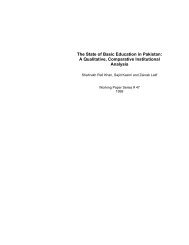

![(October - December, 2010) [13th SDC Special Bulletin]](https://img.yumpu.com/50118608/1/184x260/october-december-2010-13th-sdc-special-bulletin.jpg?quality=85)
